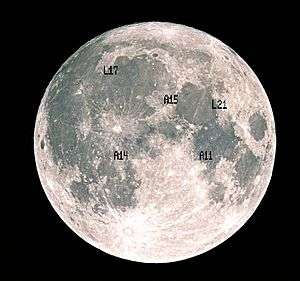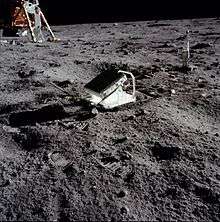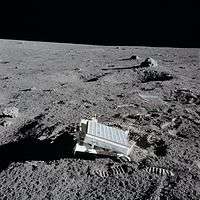List of retroreflectors on the Moon
Retroreflectors are devices which reflect light back to its source. Five were left at five sites on the Moon by three crews of the Apollo program and two remote landers of the Lunokhod program.[1] Lunar reflectors have enabled precise measurement of the Earth–Moon distance since 1969.[2]

The locations of lunar retroreflectors left by Apollo (A) and Lunokhod (L) missions.

The Lunar Laser Ranging Experiment from the Apollo 11 mission.

Apollo 14's LRRR on the lunar surface
Reflectors placed by the United States
| Name | Mission | Date | Location |
|---|---|---|---|
| Lunar Ranging Retro Reflector (LRRR)[1] | Apollo 11 | 21 July 1969[3] | 0.67337°N, 23.47293°E[4] |
| LRRR[1] | Apollo 14 | 31 January 1971[5] | 3.6453° S, 17.471361° W [5] |
| LRRR[1] (larger than previous ones, 105x65 cm) | Apollo 15 | 31 July 1971[6] | 26.1°N, 3.6°E[6] |
Reflectors placed by the Soviet Union
| Name | Mission | Date | Location |
|---|---|---|---|
| Lunokhod 1[1][lower-alpha 1] | Luna 17 | 17 November 1970[7] | 38.315°N 35.008°W[8][9] |
| Lunokhod 2[1][lower-alpha 1] | Luna 21 | 15 January 1973[10] | 25.8323°N 30.9221°E[11][12] |
Attempted placement of reflectors
| Name | Mission | Date | Location |
|---|---|---|---|
| Beresheet lander[13] | SpaceIL mission | hard landing/crashed 11 April 2019[14] | Mare Serenitatis, 32.5956° N, 19.3496° E[15] |
| Vikram lander[16] | Chandrayaan-2 | hard landing/crashed 7 September 2019 [17] | Unknown (Planned: 70.9°S, 22.7°E)[18] |
Planned reflectors by space agencies and private landers
| Name | Mission | Launch date | Planned location |
|---|---|---|---|
| MoonLIGHT[19] | MX-1E lander Flight 1 | July 2020 (planned) | Malapert Mountain near the lunar south pole[20] (84.9 S, 12.9 E) |
See also
- List of man-made objects on the Moon
- Lunar Laser Ranging experiment
Notes
- The Lunokhod retroreflectors were on the rover and not the landing stage.
References
- Lunar Retroreflectors
- Slava G. Turyshev: From Quantum to Cosmos: Fundamental Physics Research in Space (2009) - Page 300
- "What Neil & Buzz Left on the Moon: A cutting-edge science experiment left behind in the Sea of Tranquility by Apollo 11 astronauts is still running today". National Aeronautics and Space Administration. 20 July 2004. Retrieved 1 August 2012.
- "Landing Site Coordinates". www.hq.nasa.gov. Retrieved 26 July 2017.
- "APOLLO 14: The Eighth Mission: The Third Lunar Landing: 31 January–09 February 1971". National Aeronautics and Space Administration. Archived from the original on 14 November 2004. Retrieved 8 August 2012.
- Archinal, Brent (13 April 2010). "The Apollo 15 Lunar Laser Ranging Retroreflector - A Fundamental Point on the Moon!". Arizona State University. Archived from the original on 13 January 2013. Retrieved 1 August 2012.
- http://www.zarya.info/Diaries/Luna/Luna17.php
- "LROC Observation M114185541R". Arizona State University. Retrieved 8 August 2012.
- "Lunokhod 1 Revisited | Lunar Reconnaissance Orbiter Camera". lroc.sese.asu.edu. Retrieved 8 October 2019.
- http://www.zarya.info/Diaries/Luna/Luna21.php
- "LROC Coordinates of Robotic Spacecraft | Lunar Reconnaissance Orbiter Camera". lroc.sese.asu.edu. Retrieved 8 October 2019.
- "NASA - NSSDCA - Spacecraft - Details". nssdc.gsfc.nasa.gov. Retrieved 8 October 2019.
- Warner, Cheryl (10 April 2019). "Update on First Private Robotic Spacecraft Attempt at Moon Landing". NASA. Retrieved 12 April 2019.
- Beresheet crash caused by manual command, but reflector device may have survived. Georgina Torbet, Digital Trends. 21 April 2019.
- Israeli spacecraft Beresheet crash site spotted on moon, 15 May 2019
- Bartels, Meghan (24 March 2019). "How NASA Scrambled to Add Science Experiments to Israeli, Indian Moon Probes". Retrieved 25 March 2019.
- Sep 8, PTI | Updated; 2019; Ist, 21:06. "Vikram lander located on lunar surface, wasn't a soft landing: Isro | India News - Times of India". The Times of India. Retrieved 8 October 2019.CS1 maint: numeric names: authors list (link)
- Amitabh, S.; Srinivasan, T. P.; Suresh, K. (2018). Potential Landing Sites for Chandrayaan-2 Lander in Southern Hemisphere of Moon (PDF). 49th Lunar and Planetary Science Conference. 19-23 March 2018. The Woodlands, Texas. Bibcode:2018LPI....49.1975A. Archived from the original (PDF) on 22 August 2018.
- UMD, Italy & MoonEx Join to Put New Laser-Reflecting Arrays on Moon. Lee Tune, University of Maryland. 10 June 2015.
- Internatioinal Lunar Observatory to offer a new astrophysical perspective. Tonasz Nowakowski. Spaceflight Insider. 12 August 2017.
This article is issued from Wikipedia. The text is licensed under Creative Commons - Attribution - Sharealike. Additional terms may apply for the media files.